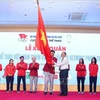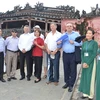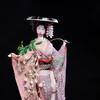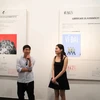 Gold artifacts belonging to the Oc Eo culture are kept at the Museum of Long An Province (Photo: Bui Giang/VNA)
Gold artifacts belonging to the Oc Eo culture are kept at the Museum of Long An Province (Photo: Bui Giang/VNA)
Hanoi (VNA) - As the name of a mound on the field southeast of Ba The mountain, in Vong The commune, Thoai Son district, An Giang province, Oc Eo entered the history of Vietnamese archeology as an attractive archaeological cultural land.
Oc Eo culture was formed and developed between the first and the seventh century.
This is a great culture in Vietnamese history, associated with the land and people in the lower Mekong Delta. It is also closely related to ancient Southeast Asian history.
This region is distributed on a very large area in the Mekong Delta, in the lowland area of the Western Hau River including many different ecological regions of the provinces from An Giang (Oc Eo-Ba The), Kien Giang (Da Noi, Nen Chua, Tan Long), Dong Thap (Dong Thap Muoi), the southwest coastal area (U Minh, Nam Can) to the coastal Sac forest (Can Gio, Giong Am) and the East Sea (from the estuary of Tien river to Ca Mau).
In addition, archeology has discovered many relics of Oc Eo culture in the provinces of Binh Duong, Binh Phuoc, Tay Ninh, Dong Nai, part of Long An, Binh Thuan and Ho Chi Minh City.
Right from the beginning of the 20th century, the first antiques of Oc Eo culture were discovered on Oc Eo-Ba The field in Vong The commune, Thoai Son district, An Giang province.
Due to their uniqueness and beauty, the relics of Oc Eo culture attracted the attention of many prominent French scholars like G. Coedès, L.Malleret, H. Parmentier.
However, this cultural study really only started with the excavation of L.Malleret at Oc Eo relic in 1944 and the following years. L.Malleret released the results of his discoveries and research in a series of books entitled "Archeology in the Mekong Delta", published from 1959-1964.
This work is considered to be the main archaeological achievement of Oc Eo Culture until before 1975.
Based on the excavations in 1944, Louis Malleret assumed that the Oc Eo field was an ancient city and was named Oc Eo city or Oc Eo port, covering an area of 450 hectares.
This region not only has the image of an organized city but also has traces of a large religious-cultural center with three architectural complexes: the area of Linh Son Pagoda, the Northeast of Ba The Mountain and the area of Giong Cat and Giong Xoai.
Surveys and excavations in Oc Eo cultural sites found large and small statues, rings, earrings, gemstones, onyx, glass beads, seals, amulets, tools bronze and stone; types of terracotta objects such as spinning thread, stove, lamp plate, pots, etc.
Oc Eo artifacts represent the richness and diversity of this culture. They feature both indigenous characteristics and cultural interaction with other regions.
The influence of Indian culture in Oc Eo is obvious, manifested through decorative themes, sitting posture of the statues, and seals with inscriptions written in Indian writings.
Meanwhile, the indigenous nature of this culture is expressed through ceramics, crucibles, molds and crafting tools.
The origin of Oc Eo culture stems from Dong Nai culture. The connection between Dong Nai-Oc Eo culture is evidenced by the presence in Oc Eo culture of various types of artifacts already present in Dong Nai culture.
These are the utensils, daily life items made of pottery, craft tools (rubs, stamping tables, grinding tables); copper, iron (rattle, nose, ax); jewelry (glass beads, onyx); stilt houses on wooden stilts.
Oc Eo culture has large cultural exchanges with ancient civilizations such as those of Dong Son civilization, India, China, the Mediterranean and the Middle East./.





















